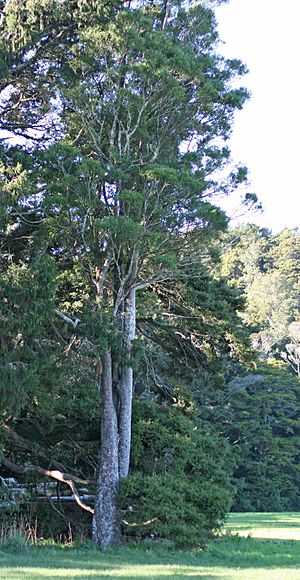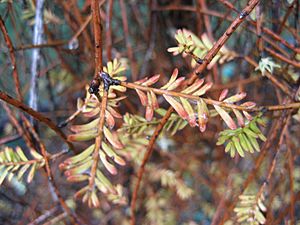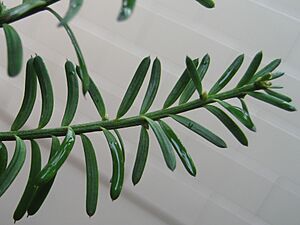Mataī facts for kids
Quick facts for kids Matai |
|
|---|---|
 |
|
| Conservation status | |
| Scientific classification | |
| Genus: |
Prumnopitys
|
| Species: |
taxifolia
|
The mataī (which is also called Prumnopitys taxifolia or black pine) is a special tree that only grows in New Zealand. It is a type of conifer tree, which means it has cones and needle-like leaves. You can find mataī trees on the North Island and South Island. They also grow on Stewart Island/Rakiura, but they are not as common there.
Mataī trees can grow very tall, sometimes up to 40 meters high. Their trunks can be as wide as 2 meters across! The leaves of the mataī are long and thin, like a sickle. They are about 10 to 15 millimeters long. Instead of regular cones, mataī trees have small, berry-like structures. These "berries" are about 10 to 15 millimeters long and turn a pretty violet-purple color when they are ripe. Inside, they have a soft, edible part that covers a single seed. The New Zealand pigeon (also known as kererū) loves to eat these berries. When the pigeons eat the berries, they help spread the mataī seeds around.
Contents
What is a Mataī Tree?
The scientific name for the mataī tree is Prumnopitys taxifolia. The word taxifolia means "yew-leaved." This is because the leaves of the mataī look a bit like the leaves of a yew tree. In the past, scientists sometimes grouped the mataī with other trees in a genus called Podocarpus. But now, it is known as a Prumnopitys tree.
You can tell the mataī apart from another similar New Zealand tree called the miro (Prumnopitys ferruginea). The mataī has shorter, thinner leaves. Its berry-like cones are also round and violet-purple, which is different from the miro.
How Mataī Trees Grow: From Young to Old
Mataī trees have a very interesting way of growing when they are young. Unlike the miro tree, the mataī has a special "juvenile" stage that lasts for many years. When a mataī is young, it looks like a tangled bush. It has many thin, flexible branches that grow in all directions. Mixed in with these branches are leaves that can be brown, pale yellow, or even dirty white.
After a long time, the adult tree starts to grow out of the top of this tangled young bush. Once the main tree begins to grow tall, the messy branches from the juvenile stage will dry up and fall off. This leaves behind the tall, straight adult mataī tree.
Mataī and Other Living Things
Mataī trees are important for some New Zealand insects. They are a "host plant" for the caterpillars of a special moth called Pyrgotis zygiana. This means the caterpillars eat the mataī leaves. The seeds of the mataī tree are also a home for another unique moth, the Heterocrossa iophaea.
Uses of Mataī Wood
The wood from mataī trees was used a lot in New Zealand, especially in the middle of the 1900s. It was very popular for making flooring in houses.
Even though mataī wood was used a lot, the tree itself is not currently in danger of disappearing. However, the forests where mataī trees were common have become much smaller because of logging. Today, there are not many large, untouched forests left that are mostly made up of mataī trees.
See also
 In Spanish: Matai para niños
In Spanish: Matai para niños




